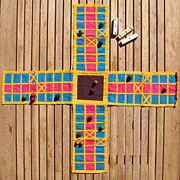
Pachisi
Encyclopedia

Cross and Circle game
Cross and Circle is a board game design used for race games played throughout the world.-Design:Strictly, the design comprises a circle divided into four equal portions by a cross inscribed inside it; the classic example of this design is Yut...
board game
Board game
A board game is a game which involves counters or pieces being moved on a pre-marked surface or "board", according to a set of rules. Games may be based on pure strategy, chance or a mixture of the two, and usually have a goal which a player aims to achieve...
that originated in ancient India
History of India
The history of India begins with evidence of human activity of Homo sapiens as long as 75,000 years ago, or with earlier hominids including Homo erectus from about 500,000 years ago. The Indus Valley Civilization, which spread and flourished in the northwestern part of the Indian subcontinent from...
which has been described as the "national game of India
India
India , officially the Republic of India , is a country in South Asia. It is the seventh-largest country by geographical area, the second-most populous country with over 1.2 billion people, and the most populous democracy in the world...
". It is played on a board shaped like a symmetrical cross. A player's pieces move around the board based upon a throw of six or seven cowrie shells, with the number of shells resting with aperture upwards indicating the number of spaces to move.
The name of the game derives from the Hindi word pachis, meaning twenty-five, the largest score that can be thrown with the cowrie shells. Thus the game is also known by the name Twenty-Five.
Parcheesi
Parcheesi
Parcheesi is a brand name American adaptation of the Indian Cross and Circle game Pachisi. Created in India perhaps as early as 500 AD, the board game is subtitled Royal Game of India because royalty played using color-costumed members of their harems as pieces on large outdoor boards. Such a court...
, Sorry!
Sorry! (game)
Sorry! is a board game that is based on the ancient Cross and Circle game Pachisi. Players try to travel around the board with their pieces faster than any other player. Distributed by Parker Brothers, Sorry! is marketed for two to four players, ages six through adult...
and Ludo
Ludo (board game)
Ludo is a simple board game for two to four players, in which the players race their four tokens from start to finish according to dice rolls. Like other cross and circle games, it is similar to the Indian Pachisi, but simpler...
are among the many Westernized
Western world
The Western world, also known as the West and the Occident , is a term referring to the countries of Western Europe , the countries of the Americas, as well all countries of Northern and Central Europe, Australia and New Zealand...
versions of the game.
Players
Pachisi is a game for four players, usually in two teams. One team has yellow and black pieces, the other team has red and green. The team which moves all its pieces to the finish first, wins the game.Equipment
Each player has four beehiveBeehive (beekeeping)
A beehive is an enclosed structure in which some honey bee species of the subgenus Apis live and raise their young. Natural beehives are naturally occurring structures occupied by honeybee colonies, while domesticated honeybees live in man-made beehives, often in an apiary. These man-made...
-shaped pieces. The pieces of one player are distinguishable from another by their colour: black, green, red and yellow are used for each player.
Six cowrie shells are used to determine the amount to move the players' pieces. They are thrown from the player's hand and the number of cowries which fall with their openings upwards indicate how many spaces the player may move:
| Cowries | Value | Another turn? |
|---|---|---|
| 0 | 25 | Another turn |
| 1 | 10 | Another turn |
| 2 | 2 | |
| 3 | 3 | |
| 4 | 4 | |
| 5 | 5 | |
| 6 | 6 | Another turn |
The board is usually embroidered
Embroidery
Embroidery is the art or handicraft of decorating fabric or other materials with needle and thread or yarn. Embroidery may also incorporate other materials such as metal strips, pearls, beads, quills, and sequins....
on cloth. The playing area is cruciform. There is a large square in the centre, called the Charkoni, which is the starting and finishing position of the pieces. The four arms are divided into three columns of eight squares. The players' pieces are moved along these columns during play.
Twelve squares are specially marked as castle squares. Four of these are positioned at the end of the middle columns of each arm; the other eight are four squares inwards from the end of the outer columns on each arm. A piece may not be captured by an opponent while it lies on a castle square.
Play
Each player's objective is to move all four of their pieces completely around the board, counter-clockwise, before their opponents do. The pieces start and finish on the Charkoni.The playing order is decided by each player throwing the cowries. The player with the highest score starts, and turns continue counter-clockwise around the board.
Each player's first piece may leave the Charkoni on any throw. Each player moves their pieces down the centre column of their own arm of the board, then counter-clockwise around the outside columns.
A player may have any number of their pieces on the board at one time. One piece only may be moved with a single throw, or if the player chooses, they can decline to move any piece on a throw.
If a 6, 10 or 25 is thrown, the player gets a grace. This enables them to introduce another of their pieces from the Charkoni onto the board, and they also get to repeat their turn.
More than one piece of the same team may occupy a single square. However a piece may not move onto a castle square that is already occupied by an opponent's piece.
If a piece lands on a square (other than a castle square) occupied by any number of the opponent's pieces, those pieces are captured and must return to the Charkoni. Captured pieces may only enter the game again with a grace throw. A player making a capture is allowed another turn.
A piece completes its trip around the board by moving back up its central column. Returning pieces may be placed on their side in order to distinguish them from pieces that have just entered. A piece can only return to the Charkoni by a direct throw.
Four of the castle squares are placed so that they are exactly 25 moves from the Charkoni. A common strategy is for returning pieces to stay on these squares, where they are safe from capture, until a 25 is thrown. Then they can finish the game directly. This is where the name of the game comes from.
History
Pachisi may be quite ancient, but so far its history has not been established prior to the 16th century. A 6th- or 7th-century representation of Lord ShivaShiva
Shiva is a major Hindu deity, and is the destroyer god or transformer among the Trimurti, the Hindu Trinity of the primary aspects of the divine. God Shiva is a yogi who has notice of everything that happens in the world and is the main aspect of life. Yet one with great power lives a life of a...
and the Goddess Parvati
Parvati
Parvati is a Hindu goddess. Parvati is Shakti, the wife of Shiva and the gentle aspect of Mahadevi, the Great Goddess...
said to be playing Chaupar
Chaupar
Chaupar is a board game of the Cross and Circle family played in India that is very similar to Pachisi. It is believed that both games were created around the 4th century. The board is made of wool or cloth. The dice are six cowry shells and the pawns are made of wood...
(a closely related game) in fact depicts only dice and not the distinctive board. A Sung period (960–1279) document referencing the Chinese game t'shu-p'u "invented in western India and spread to China in the time of the Wei Dynasty (AD 220–265)" may relate to Chaupar, but the actual nature of the Chinese game (which may be more closely related to Backgammon
Backgammon
Backgammon is one of the oldest board games for two players. The playing pieces are moved according to the roll of dice, and players win by removing all of their pieces from the board. There are many variants of backgammon, most of which share common traits...
) is uncertain. Speculation that Pachisi derived from the earlier game of Ashtapada is plausible but unsubstantiated.

Fatehpur Sikri
Fatehpur Sikri is a city and a municipal board in Agra district in the state of Uttar Pradesh, India. Built near the much older Sikri, the historical city of Fatehabad, as it was first named, was constructed by Mughal emperor Akbar beginning in 1570...
in northern India:
The game of Pachisi was played by Akbar in a truly regal manner. The Court itself, divided into red and white squares, being the board, and an enormous stone raised on four feet, representing the central point. It was here that Akbar and his courtiers played this game; sixteen young slaves from the harem wearing the players' colours, represented the pieces, and moved to the squares according to the throw of the dice. It is said that the Emperor took such a fancy to playing the game on this grand scale that he had a court for pachisi constructed in all his palaces, and traces of such are still visible at AgraAgraAgra a.k.a. Akbarabad is a city on the banks of the river Yamuna in the northern state of Uttar Pradesh, India, west of state capital, Lucknow and south from national capital New Delhi. With a population of 1,686,976 , it is one of the most populous cities in Uttar Pradesh and the 19th most...
and AllahabadAllahabadAllahabad , or Settled by God in Persian, is a major city of India and is one of the main holy cities of Hinduism. It was renamed by the Mughals from the ancient name of Prayaga , and is by some accounts the second-oldest city in India. It is located in the north Indian state of Uttar Pradesh,...
.
Finkel adds:
To date, these grandiose boards still represent the earliest secure evidence for the existence of the game in India. The game's role in the history of India still remains to be investigated. It is often assumed that the gambling game that plays so significant a role in the MahabharataMahabharataThe Mahabharata is one of the two major Sanskrit epics of ancient India and Nepal, the other being the Ramayana. The epic is part of itihasa....
, the classical literary epic, is pachisi, but the descriptions, such as they are, do not tie in with the game, and this conclusion is perhaps erroneous.
See also
- Ashte kashteAshte kashteAshta-kashte is a race board game from Bengal akin to the Cross and Circle family for two to four players originating in India. Although there is no evidence for that, it is considered by some as the direct ancestor of Pachisi. It is played on a board with a 7-by-7 grid on it...
, a game with similar rules - Other cross and circle games

